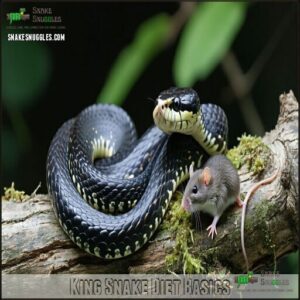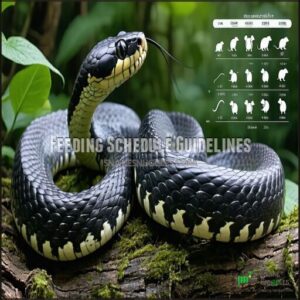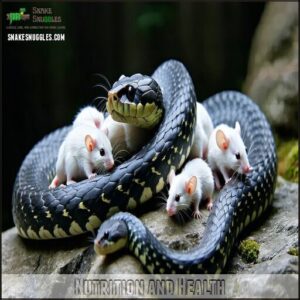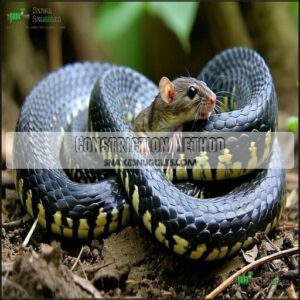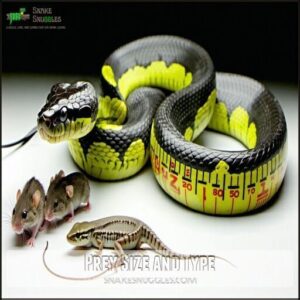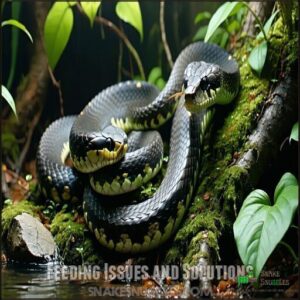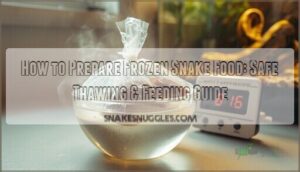This site is supported by our readers. We may earn a commission, at no cost to you, if you purchase through links.
 A king snake’s diet consists primarily of appropriately sized rodents like mice and rats, which provide essential nutrients. They’re also famous for eating other snakes, including venomous ones, thanks to their immunity to certain venoms.
A king snake’s diet consists primarily of appropriately sized rodents like mice and rats, which provide essential nutrients. They’re also famous for eating other snakes, including venomous ones, thanks to their immunity to certain venoms.
Occasionally, they’ll enjoy lizards, bird eggs, or small amphibians like frogs. Younger or smaller snakes eat more frequently—every 5–7 days—while adults typically need feeding once every 10–14 days.
Always match prey size to the midsection of your snake, and avoid feeding during shedding. Providing a varied diet guarantees balanced nutrition and helps mimic their natural habits.
Curious about feeding challenges or techniques? There’s more to explore.
Table Of Contents
Key Takeaways
- Feed your king snake a meat-only diet with appropriately sized rodents like mice or rats, occasionally including lizards, bird eggs, or small birds for variety.
- Match prey size to your snake’s thickest body part and adjust portion sizes based on its age and condition to avoid underfeeding or obesity.
- Stick to frozen-thawed prey instead of live or wild-caught options to ensure safety and prevent parasites or injuries.
- Avoid feeding during shedding, handle your snake 48 hours after meals, and maintain proper enclosure temperatures for healthy digestion.
King Snake Diet Basics
When you’re caring for a king snake, you’ll discover these adaptable predators naturally thrive on a diet that closely matches their wild feeding habits.
As a carnivorous reptile known for eating everything from rodents to other snakes, understanding your king snake’s nutritional needs means providing whole prey items like mice and small rats.
With portion sizes and feeding frequency that change as your snake grows from a hatchling to adult, it’s essential to tailor your approach to meet the unique needs of your pet at each stage of development.
Primary Food Sources
King snakes thrive on a meat-only diet, primarily feeding on rodents like mice and rats.
These slithering carnivores demand a strictly meat-based menu, with mice and rats topping their gourmet preferences.
These skillful hunters also consume lizards, birds, eggs, and remarkably, other snakes including venomous species.
While wild diets vary extensively, captive king snakes do best with properly sized, frozen-thawed rodents that match their body thickness, and offering alternative prey occasionally can mirror natural feeding behavior and guarantee complete nutrition.
Diet Size and Frequency
When planning your king snake’s meals, consider both meal size and feeding intervals carefully.
Prey should match your snake’s thickest body part and weigh around 10% of their body weight.
Age influences feeding frequency: babies need food every 5-7 days, juveniles every 7-10 days, and adults every 10-14 days.
Seasonal changes may affect appetite, requiring lighter winter feeding schedules to maintain proper portion sizes.
Age and Size Considerations
When determining proper feeding amounts for your king snake, you’ll need to examine their life stage and body size carefully.
Hatchlings require pinky mice every 5-7 days, while juveniles need larger prey at similar intervals.
Adults thrive on mice every 10-14 days, but monitor for signs of adult obesity.
Always match prey proportions to your snake’s widest body part, adjusting for growth stages to guarantee healthy development and well-being throughout their life.
Feeding Schedule Guidelines
You’ll need to adjust your king snake’s feeding schedule based on its age, with younger snakes requiring more frequent meals than adults.
Establishing a consistent feeding routine will help your snake maintain ideal health and growth, while preventing common issues like obesity or nutritional deficiencies.
Hatchling Feeding
Nearly all king snake hatchlings start with pinky mice as their initial meals. Their tiny size requires careful portion control and consistent feeding frequency to support their rapid growth rate.
For successful hatchling feeding, it is essential to follow a structured approach.
- Offer appropriately sized pinky mice every 5-7 days
- Watch for pre-shedding fasting (they’ll typically refuse food when shedding)
- Adjust meal size as they grow (one pinky should bulge slightly in their midsection)
Juvenile Feeding
Juvenile king snakes step up their dietary needs as they grow into their scales.
Your growing snake requires proper portion control and consistent feeding frequency to support healthy development.
| Age Range | Prey Size | Feeding Schedule |
|---|---|---|
| 3-6 months | Fuzzy mice | Every 5-7 days |
| 6-12 months | Hoppers | Every 7 days |
| 12-18 months | Small adult mice | Every 7-10 days |
Gradually increase prey size as your juvenile develops, always ensuring it matches the snake’s widest body part.
It’s also important to bear in mind snake feeding frequency to avoid over or underfeeding.
This consideration is crucial for the healthy development of your snake.
Remember to check the feeding schedule regularly.
Adult Feeding
Adult king snakes thrive on a consistent feeding schedule adapted to their size and metabolism.
Feed your adult king snake every 7-10 days with appropriately sized prey.
- Choose prey approximately 1-1.5 times the width of your snake’s mid-body
- Offer one adult mouse or small rat per feeding session
- Monitor weight to prevent obesity risks
- Always use frozen-thawed prey for safety
- Consider rotating prey types for a varied diet
Nutrition and Health
You’ll need to provide your king snake with a balanced diet of properly sized whole prey to guarantee healthy and longevity.
The nutritional value from various prey items, especially calcium-rich rodents, supports everything from proper bone development to successful shedding cycles.
Balanced Diet Importance
A balanced diet forms the cornerstone of your king snake’s health.
By providing nutrient variety through proper prey rotation, you’re replicating their wild feeding habits. King snake diet should include appropriately sized rodents with occasional alternatives to support their instinctual behavior.
This wild replication offers significant health benefits, including proper growth, immune function, and longevity.
Remember, consistent feeding habits maintain ideal snake nutrition without risking nutritional deficiencies.
Nutritional Variety
While a stable feeding routine supports your king snake’s health, variety keeps their diet complete.
Just as humans need different foods, your snake benefits from prey rotation. Mix up their menu with mice, chicks, quail eggs, and even lizards occasionally.
This snake diet variety mimics their natural hunting patterns, providing diverse nutrients they’d find in the wild. Some owners report more active, engaged snakes when switching between food options regularly, which can lead to a more complete diet.
Calcium and Protein Sources
While varied prey offers different nutrients, understanding specific calcium and protein sources guarantees your king snake thrives. Rodents provide complete nutrition, serving as the cornerstone of your snake’s diet.
For ideal snake nutrition, consider these calcium-rich sources:
- Mice and rats with bones (80% of diet)
- Quail eggs (excellent calcium-phosphorus ratio)
- Small birds (higher calcium than rodents)
- Lizards (natural protein diversity)
You’ll rarely need supplements when feeding whole prey items. Be aware that soft jaw symptoms can indicate a calcium deficiency.
Feeding Techniques and Behavior
You’ll need to understand how king snakes use constriction to subdue their prey before swallowing it whole, a fascinating process that makes feeding time both efficient and mesmerizing.
When offering appropriately sized prey (no larger than 1.5 times the snake’s widest part), you’ll notice your king snake tracking by scent, striking quickly, and then squeezing until the prey stops moving, showing their remarkable hunting instincts even in captivity, which is a testament to their efficient nature.
Constriction Method
Every king snake uses constriction as their primary hunting technique.
When they detect prey with their sensitive tongues, they strike quickly and wrap their muscular body around the victim.
Their remarkable constriction strength cuts off blood flow rather than causing suffocation.
This evolutionary advantage allows them to subdue prey efficiently before swallowing it whole.
You’ll notice their muscle control tightens with each exhale of their prey, showcasing their efficient hunting method with muscular body.
Prey Size and Type
Now that you’ve learned how king snakes subdue their prey, let’s look at what they should actually eat.
Your king snake’s prey size should match its body width—never exceeding 1.5 times the snake’s thickest part.
Frozen-thawed rodents are safer than live options, providing complete nutrition.
While mice form the foundation of a king snake diet, incorporating alternative prey like appropriately sized lizards can offer valuable enrichment.
Consider appropriate rodent sizes for ideal feeding.
Remember: a proper meal should be about 10% of your snake’s body weight.
Eating Habits and Patterns
King snakes have fascinating eating habits that reflect their wild ancestry.
They’ll track prey using their forked tongue to "taste" the air, following scent trails with remarkable precision.
Your snake will typically consume prey headfirst, using powerful constriction to subdue it first.
After a substantial meal, expect periods of inactivity as digestion rates slow, and their feeding frequency naturally adjusts with seasonal changes and activity levels, which is influenced by their wild ancestry.
Dietary Variety and Rotation
You’ll enhance your king snake’s health by offering a variety of prey items including mice, birds, eggs, and lizards rather than relying solely on one food source.
Rotating between different prey types mimics your snake’s natural feeding patterns in the wild, ensuring a complete nutritional profile while also stimulating their natural hunting instincts.
Prey Rotation Benefits
Rotating different prey types offers your king snake substantial benefits beyond just mimicking their natural hunting patterns.
Rotating prey types stimulates natural instincts, enhances nutrient diversity, and keeps your king snake engaged and healthy.
A varied diet provides better nutrient diversity, which supports peak health and immune function.
You’ll notice your snake showing more interest during feeding time as different prey items stimulate their hunting instincts.
This instinctual stimulation prevents feeding boredom and encourages natural behaviors.
Healthier snakes with diverse diets typically display better coloration, more energy, and fewer digestive issues over time.
Eggs and Birds as Prey
Many king snakes enjoy eggs and birds as part of their varied diet, adding essential nutrients that might be missing from rodent-only feeding regimens.
You can incorporate these prey items occasionally to mimic their natural feeding patterns.
- Quail eggs offer calcium-rich nutrition and can be fed whole to adult king snakes
- Small bird hatchlings (like quail chicks) provide diverse nutrients not found in mice
- Frozen-thawed chicks are safer alternatives to wild birds, eliminating parasite risks
- Egg yolks can be offered as a calcium supplement during growth periods
Lizards and Other Prey
Beyond rodents, your king snake will thrive on lizards and other prey that mirror their natural diet.
Lizards offer excellent nutrition and stimulate natural hunting behaviors.
You’ll find that king snakes occasionally consume frogs, turtle eggs, and smaller snakes—including venomous species they’re immune to.
This dietary variety prevents nutritional deficiencies and keeps feeding time interesting.
For peak health, rotate these options throughout your snake’s feeding schedule.
Kingsnakes are primarily terrestrial, and often hide under logs in their natural habitat.
Feeding Issues and Solutions
You’ll likely encounter feeding issues with your king snake at some point, from food refusal during shedding to potential regurgitation if handled too soon after meals.
Understanding these common problems will help you address them promptly, ensuring your snake maintains proper nutrition and avoids stress-related health complications.
Refusal to Eat Causes
Your king snake’s refusal to eat can puzzle even experienced owners.
Common causes include stress-induced anorexia from over-handling or environmental changes, shedding cycles (noticeable by milky eyes), incorrect temperatures that slow digestion, underlying illness requiring veterinary attention, or parasite infestation affecting appetite.
During breeding season, snakes may temporarily lose interest in their king snake diet.
Always monitor feeding habits carefully – occasional fasting is normal, but prolonged food rejection warrants investigation into possible causes such as underlying illness or parasite infestation, and consider the impact of environmental changes.
Regurgitation Prevention
After you identify why your king snake isn’t eating, preventing regurgitation becomes your next priority.
Never handle your snake within 48 hours of feeding, as movement disrupts digestion. Maintain a proper temperature gradient (84-88°F warm side) to aid digestion.
Keep portion size manageable—prey shouldn’t exceed 1.5 times your snake’s mid-body width. Reduce stress by feeding in a quiet environment.
Understanding environmental stress factors is also vital to preventing regurgitation. These simple steps help guarantee your king snake’s meal stays where it belongs.
Obesity and Overfeeding
Your king snake’s health depends on proper portion control. Overfeeding leads to obesity, characterized by excessive weight gain and visible fat deposits along the spine.
Watch for a snake that has difficulty moving or appears sluggish. Adjust feeding frequency based on body condition and metabolic rate.
Remember, prey size should only be 10-15% of your snake’s body weight. A properly fed snake maintains a rounded, not flabby, body shape.
Environmental Considerations
You’ll need to create proper environmental conditions for your king snake to support healthy digestion and feeding behaviors, including appropriate temperature gradients (84-88°F warm side, 70-75°F cool side) and correct humidity levels (40-60%).
Your snake’s enclosure setup directly affects its metabolism and appetite, so maintaining these conditions will help guarantee your pet maintains regular feeding patterns and properly processes nutrients from its meals.
Terrarium Size and Setup
After addressing feeding issues, you’ll want to make certain your king snake has proper housing.
Your terrarium should be at least 40 gallons for adult king snakes, providing ample space to move and explore.
Choose appropriate substrate types like aspen shavings or reptile carpet—never sand, gravel, or cat litter.
Include multiple hiding places using cork bark or commercial reptile shelters.
This setup creates the security your snake needs for proper digestion and overall health.
To find appropriate supplies, one can browse a king snake terrarium.
Temperature and Humidity
With your terrarium properly sized, maintaining the right temperature and humidity becomes your next focus.
King snakes thrive in a thermal gradient environment with temperatures between 75-85°F and a basking spot of 88-90°F.
Keep humidity levels at 40-60% to support healthy feeding and shedding cycles.
A key aspect is maintaining the correct ambient temperature for overall health, which involves making seasonal adjustments to mimic natural conditions.
Digital monitoring tools help you track these essential parameters for prime snake care, ensuring you can provide the best environment for your pet.
Substrate and Lighting Options
For your king snake’s health, choose the right substrate and lighting combination.
Avoid sand or cedar chips that can cause respiratory issues; instead, opt for aspen shavings, cypress mulch, or reptile carpet.
Your snake enclosure needs proper lighting that creates a temperature gradient—use a UVB bulb during the day and a ceramic heat emitter at night for ideal conditions.
Many retailers offer suitable bedding options for king snakes.
Humidity control is simpler with moisture-retaining substrates, making it easier to maintain the right environment for your king snake.
King Snake Feeding Frequency
You’ll need to adjust your king snake’s feeding schedule based on its age, with younger snakes requiring meals every 5-7 days and adults eating every 7-14 days.
As your snake grows, you’ll notice its appetite changing, making it important to monitor its body condition and adjust portion sizes accordingly to maintain ideal health.
Young Snake Feeding
During the early life stages, your king snake requires more frequent feeding to support rapid growth.
Young snakes thrive on a consistent schedule with appropriately sized prey.
For ideal development:
- Feed hatchlings pinky mice every 5-7 days
- Adjust prey size as they grow (one pinky mouse should match the widest part of their body)
- Monitor weight gain and shedding schedules to determine if feeding frequency needs adjustment
This schedule is crucial for the snake’s overall health and development.
Adult Snake Feeding
Once your king snake reaches adulthood, establish a consistent feeding schedule of every 7-10 days.
Adult snakes typically thrive on appropriately sized mice or small rats, with prey size matching the widest part of your snake’s body.
Always offer frozen-thawed rodents for safety, and watch for signs of obesity by monitoring body condition—a healthy adult king snake should have a gently rounded, not square, cross-section, to ensure a healthy adult life.
Feeding Frequency Adjustments
Now that you’ve established a feeding routine for your adult king snake, it’s important to adjust feeding frequency based on changing circumstances.
Your snake’s metabolism fluctuates with seasonal changes, health conditions, and activity level.
During winter months, you might reduce feedings to every 14 days, while active summer periods may require weekly meals.
Always monitor your snake’s weight and body condition—a healthy king snake should feel firm but not overly plump, to ensure you’re providing the best care for your snake’s overall health.
Special Feeding Considerations
You’ll need to adjust your feeding practices for certain situations that affect your king snake’s appetite and digestion, including during shedding periods when they typically refuse food.
Your snake’s health depends on understanding these special circumstances, such as avoiding handling immediately after meals and never offering wild-caught prey that could introduce harmful parasites or diseases, including the risk of harmful parasites or diseases.
Wild-Caught Prey Risks
After establishing a regular feeding schedule for your king snake, it’s important to understand why wild-caught prey should be avoided.
Wild-caught animals often carry parasites, harmful bacteria, and toxins that can lead to serious infections and illness in your pet.
Unlike their wild counterparts, captive king snakes haven’t developed natural immunities to these threats, raising ethical concerns and legal issues with collecting wild animals for food.
Stick with commercially bred, frozen-thawed prey for maximum safety.
Shedding and Feeding
Unlike rodent concerns we just covered, you’ll notice your King Snake may refuse meals when it’s preparing to shed. This is completely normal snake behavior.
During the shedding process:
- Watch for cloudy eyes (the "blue phase") as the first sign feeding refusal might begin
- Wait 24-48 hours post-shed before attempting to feed
- Maintain proper hydration to prevent stuck sheds
- Avoid handling during this sensitive time to minimize shedding stress
Your snake’s appetite typically returns with vigor after completing a successful shed.
Handling and Feeding Guidelines
When handling your king snake, always wait at least 48 hours after feeding to prevent regurgitation.
You’ll want to establish consistent feeding routines while following these guidelines.
| Handling Factor | Feeding Guideline |
|---|---|
| Timing | Never handle immediately before or after meals |
| Frequency | Wait 48+ hours post-feeding before handling |
| Environment | Feed in separate container to avoid substrate ingestion |
| Temperature | Verify proper digestion temperature (85-88°F) |
| Stress Signs | Skip handling if snake shows stress behaviors |
To ensure the snake’s health and safety, it’s crucial to follow the provided feeding guidelines and be aware of the snake’s condition, especially in terms of digestion temperature.
Frequently Asked Questions (FAQs)
Can king snakes eat fish or amphibians?
Think of king snakes as opportunistic diners—they can eat fish or amphibians, but it’s not ideal for captivity.
Stick to rodents or small birds for balanced nutrition, ensuring safety and mimicking their natural diet.
What precautions should I take before feeding?
Make sure prey matches your snake’s size, is properly thawed, and warmed to room temperature.
Feed in a separate enclosure to prevent substrate ingestion.
Observe the snake’s behavior, avoiding feeding during stress, shedding, or illness, and ensure you are aware of the snake’s condition to provide the best care.
How do king snakes hunt in the wild?
Imagine this: a king snake flicks its tongue, “tasting” the air for prey.
It tracks scents, stalks silently, and quickly strikes.
Using powerful coils, it constricts and subdues prey, swallowing it whole—headfirst for simplicity, which is a silent process.
Are there seasonal changes in diet preferences?
King snakes’ diet can shift seasonally, especially in the wild.
During warmer months, they’re more active, eating frequently.
Colder seasons bring less movement, so their appetite decreases, and they may skip meals altogether while conserving energy.
Their diet and activity level are closely linked to the seasons, with warmer months prompting more frequent eating.
Conclusion
Think of feeding your king snake as crafting a masterpiece—it requires balance, variety, and consistency.
By understanding the king snake diet and feeding habits, you can guarantee your snake thrives, from hatchling to adulthood.
Prioritize appropriate prey size and feeding frequency, and remember that a diverse diet fosters better health.
Always monitor your snake’s behavior, especially during shedding or if it refuses food, to support its natural instincts and overall well-being.
With proper care and attention, you’ll ensure your snake receives the best possible support for its health and development.

